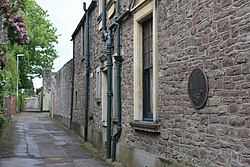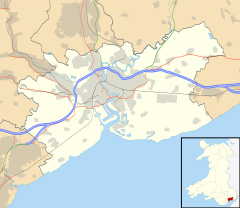| The Mynde | |
|---|---|
 The town walls that guard the Mynde The town walls that guard the Mynde | |
 | |
| General information | |
| Architectural style | Modern (house) Regency era walls Roman and Medieval (foundations) |
| Town or city | Caerleon, Newport |
| Country | Wales |
| Coordinates | 51°36′34″N 2°57′06″W / 51.609445°N 2.951748°W / 51.609445; -2.951748 |
| Completed | 1067–1075 (castle) 1839 (walls) |
| Renovated | 1928, 1938, 1978 |
| Technical details | |
| Size | 8,100 sq ft house 3.5 acres land |
The Mynde (Welsh: Y Mynde) is a historic site and property located in Caerleon on the northern outskirts of the city of Newport. The town is the historic site of the Isca Augusta Roman Fortress.
History
Roman Era
Main article: Isca AugustaCaerleon has been settled since 75 AD on the arrival of the Roman legion which established their port and outpost. The town has a number of well preserved Roman sites including Caerleon Amphitheatre, military bath houses, Field Barracks, and the fortress wall, which is 12 feet (3.7m) high.
The site has been linked as a burial place of King Arthur, with Nennius' 830 AD work Historia Brittonum referring to 'The City Of The Legion', a city some believe is Caerleon. The Castle of Caerleon is believed to have been established on the site between 1067 and 1075 during the Anglo-Norman advance from Chepstow to the west.
Chartism and 19th-century expansion
Main article: Chartist UprisingLand in the area would have consisted of Roman and medieval stone ruins until the 19th century, when stone was moved and soil filled on the site to construct walls for the present day Mynde. The present site was formed in 1839 to protect the then owner, local industrialist John Jenkins, from the Chartist protesters fighting for universal suffrage in Newport. At the time it is believed that extensive remains of a Roman villa were uncovered.
Present day
Main article: Caerleon Arts FestivalThe site is a special interest site registered by the Welsh conservation body Cadw, and the walls surrounding the land are a Grade II listed structure. Local figure Dr Russell Rhys, founder of the Caerleon Arts Festival, previously resided on the site, where he also established the Ffwrwm arts centre opposite the Mynde. The freehold has been acquired by the Celtic Manor Resort for use as a retreat and luxury residence.
The building
The current property is a 8,100 sq ft (750 m) house built in 1928, in a 3.5-acre (1.4 ha) walled site.
References
- "Caerleon – City of the Legion". National Museum Wales. Retrieved 3 March 2019.
- ^ Saltmarsh, Abigail (25 June 2015). "At the Mynde, Pieces of History Are Above Ground". The New York Times. ISSN 0362-4331. Retrieved 3 March 2019.
- Stuff, Good. "Garden Wall of The Mynde, Caerleon, Newport". britishlistedbuildings.co.uk. Retrieved 3 March 2019.
- "Caerleon doctor and arts patron Russell Rhys, dies". South Wales Argus. 15 October 2011. Retrieved 3 March 2019.
- "Historic walled home linked to King Arthur snapped up by Celtic Manor Resort as 'exclusive retreat'". South Wales Argus. 26 September 2016. Retrieved 3 March 2019.
External links
| Caerleon, Wales | |||||||||||
|---|---|---|---|---|---|---|---|---|---|---|---|
| Topics |  | ||||||||||
| Culture | |||||||||||
| Events | |||||||||||
| Infrastructure |
| ||||||||||
| Health | |||||||||||
| Education | |||||||||||
| Sports | |||||||||||
| Places | |||||||||||
| Religion | |||||||||||
| Influences | |||||||||||
| History of Caerleon, Wales | ||
|---|---|---|
| Roman Caerleon |  | |
| Kingdom of Gwent | ||
| Sites | ||
| Rumoured | ||
51°36′32″N 2°57′10″W / 51.608975°N 2.952855°W / 51.608975; -2.952855
Categories: